Dental SEO Expert Marketing Services
$999/mon to $1499/mon using PLATINUM Service
Dental SEO (Search Engine Optimization) or SEO for dentists and dental practices is complex and is constantly changing. Dental SEO has specific benefits for your dental practice: 1) Increased website traffic 2) Higher brand recognition 3) Higher new patient acquisition 4) Higher existing patient satisfaction 5) Higher visibility in your local community.
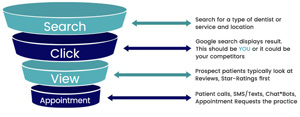
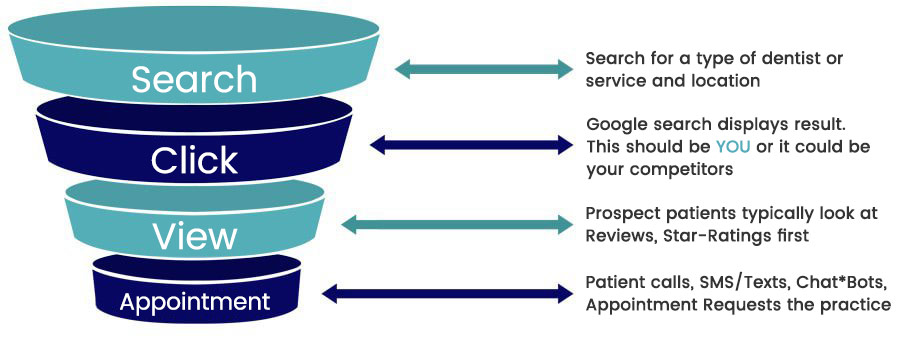
Dental search engine optimization, refers to the process of improving your dental website’s search engine ranking to reach and attract more patients who are need of your dental practice’s services. Dental SEO is based on data science, human behavior, search algorithms, and 200+ factors considered by Google ‘s search engine. Dental SEO (Search engine optimization) is also known as Natural SEO. It implies that a search engine’s results are displayed “naturally” without paying for ads. However, this is a very simplistic view. These days, for dentists if SEO is done properly, you can have excellent SEO results, and you may not have to pay for ads, however the only issue is that it takes a several months to develop SEO for your dental website. Dental marketing experts are also known as dental SEO experts. They are used interchangeably by the dental practice managers and dentists. Generally the practice managers mean that they are looking for an expert, professional who can help them with patient acquisition and retention for their dental practice, using ROI based marketing and advertising. ROI stands for Return On Investment. Majority of dental practice managers focus on measuring the ROI from the practice’s dental marketing investments. Per www.statista.com, around 30 percent of global web traffic is generated via online search, and as millions of people flock to websites such as Google for services and products research every day. So if you want to increase the SEO of your dental practice’s website, start with 1) Add good content about each and every service you offer 2) Remove anything that makes your website slow 3) Update the software of the website so it does not have any code that is not being used 4) Update the structure of the website 5) Build links within the website, outside and to the website. If the your dental website is built and used properly, conversion from Google search is 3 times higher than from social media sites. However, if you are building your brand, then social media is a better channel.
Basically, dental practices like yours, typically experience the following: (This is collected from hundreds of our customers)
Some or all of this may apply to you:
1) You may have hired someone to build the website – Website looks pretty, but does not perform
2) You may have spent thousands of dollars on your dental SEO marketing
3) You may have spent a lot of time trying to figure out what works and what does not work. (trial and error)
4) You may have mostly received substandard support from your dental SEO company
5) Return on your investment (ROI) is not justifiable
6) It is hard to find experts who can guide you with your dental SEO marketing and advertising
7) There are no useful and accountable live dashboards to show you performance of your online strategy – At most, some reports are sent to you once a month.
Example of dental SEO performance of a dental practice in a very competitive area
Data examples:
67 clicks on keyword “dentist near me”
25 clicks on keyword “dental implants near me”
24 clicks on keyword “dental implant cost”
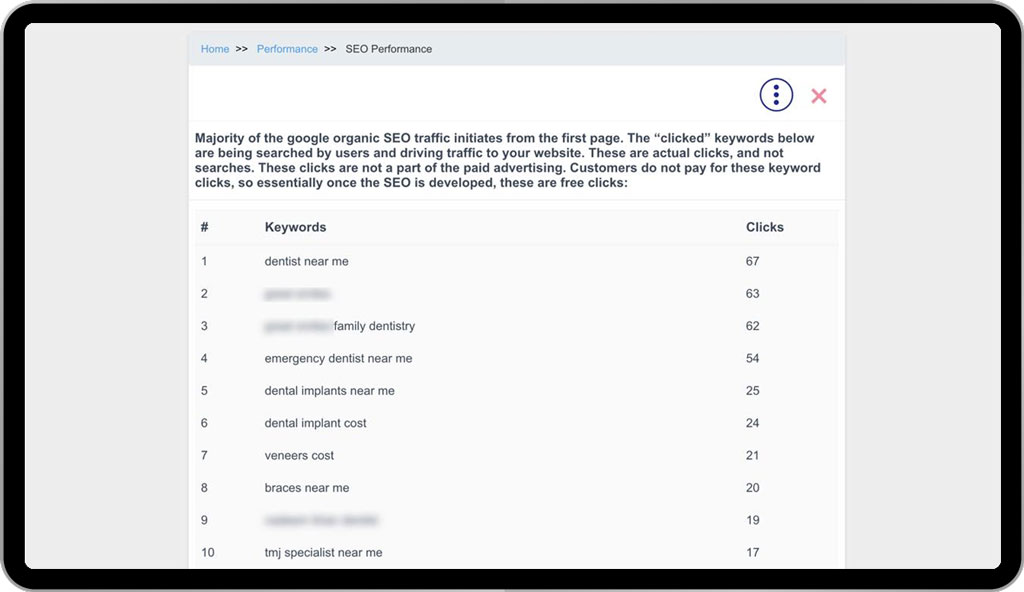

Example of dental website new patient leads in a very competitive area
Data examples:
Month of January: 1096 total leads received – 855 effective leads
Month of December: 870 total leads received – 679 effective leads
Month of November: 822 total leads received – 641 effective leads
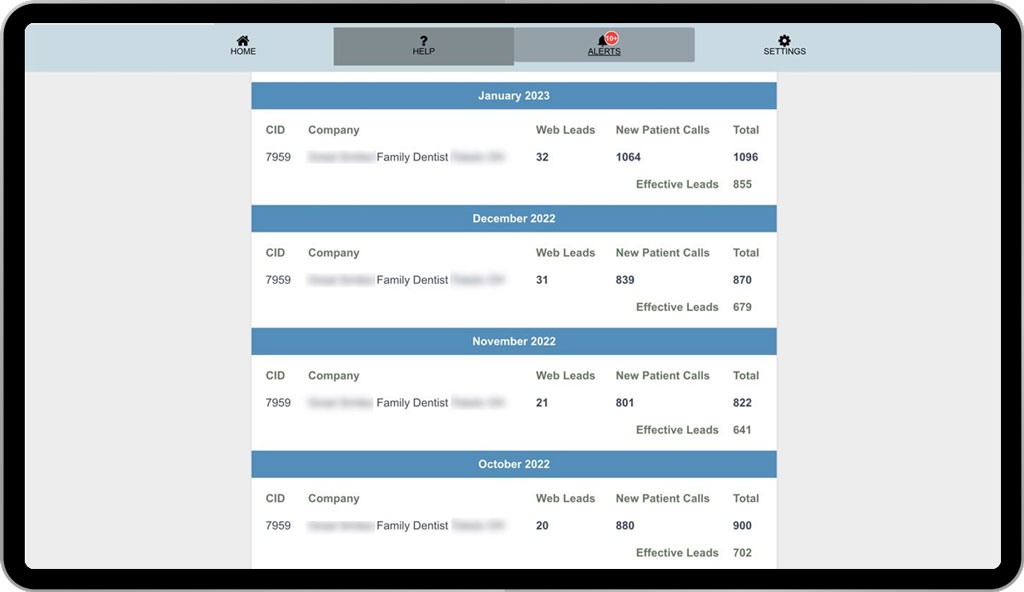
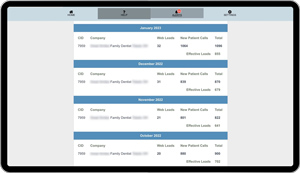
Example 1: Dental SEO for a implant dentistry in DFW area, Dallas Fort-Worth TX area with focus on implant dentistry
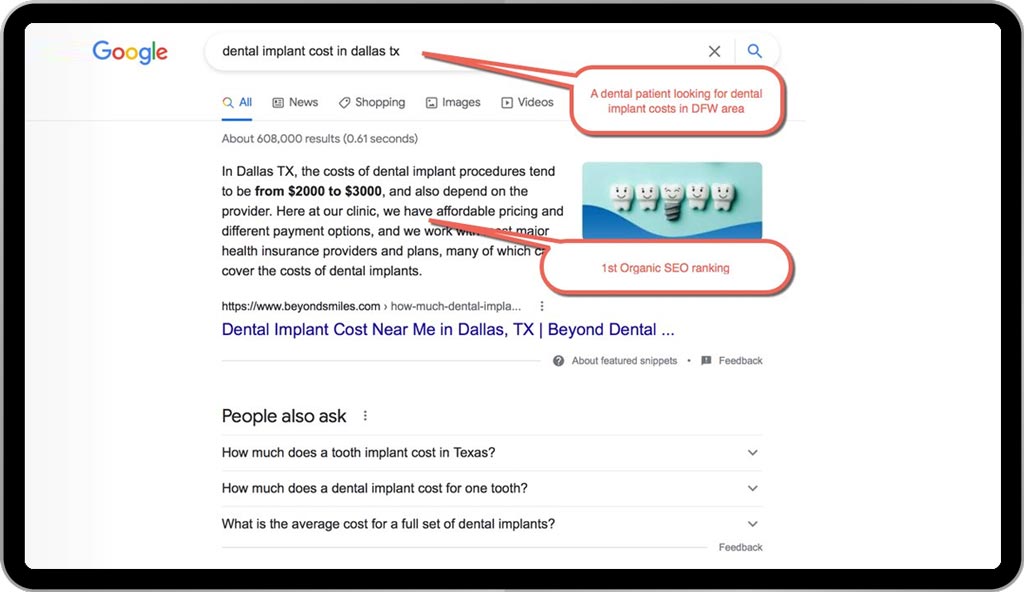
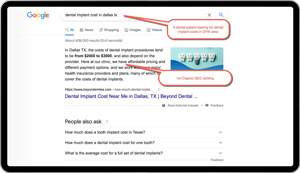
Example 2: Dental SEO for a family dentistry in Toledo OH area, with focus on family dentist
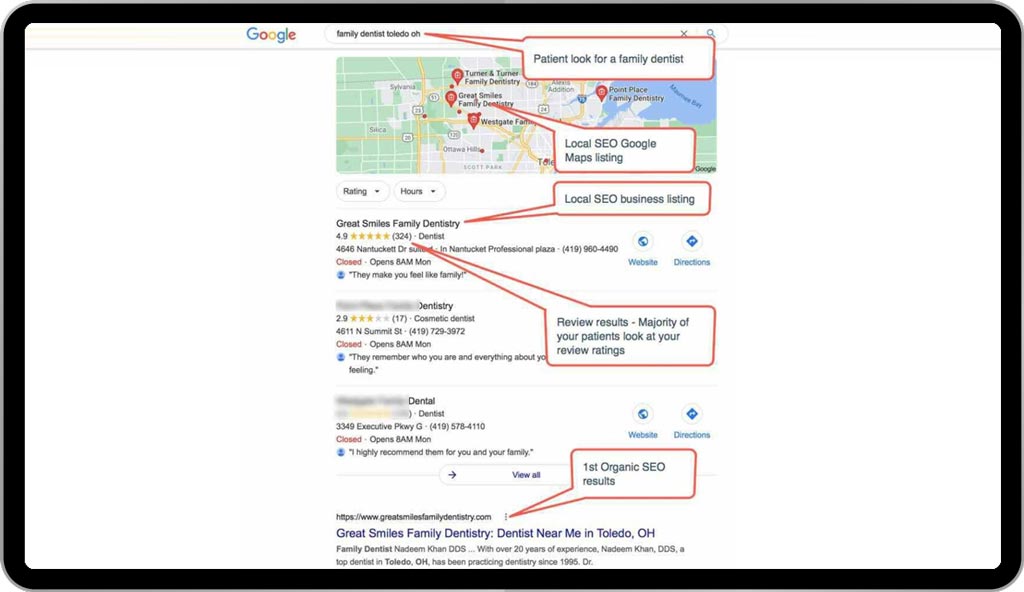
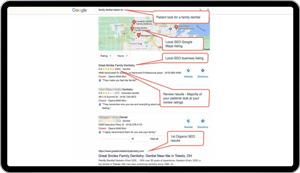
Example 3: Dental SEO for a dental provider. Patient looking for a specific dental provider
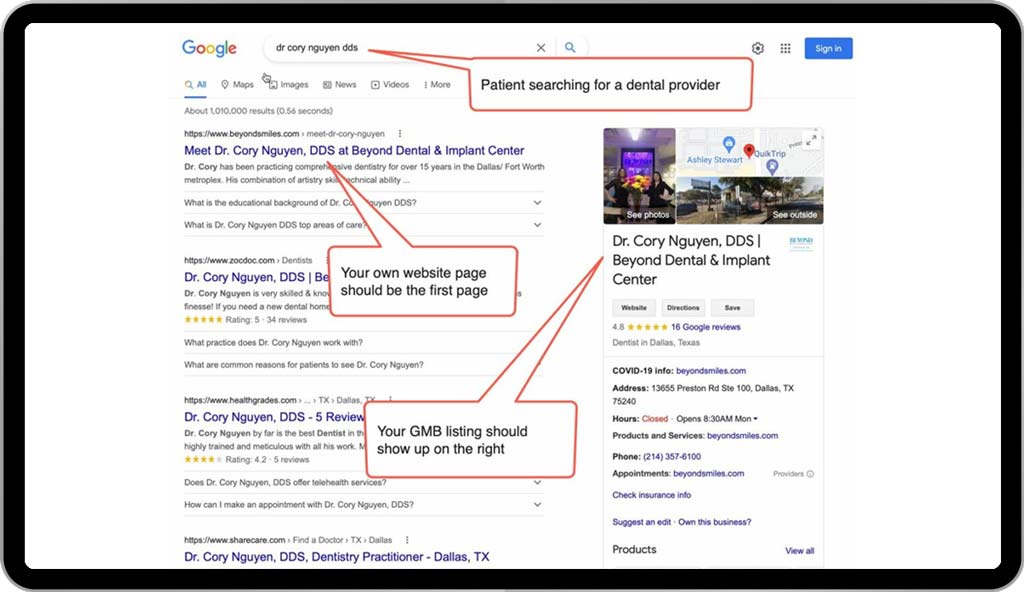
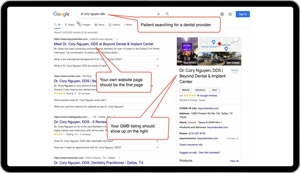
Example 4: Dental SEO for a endodontists – root canal provider in Washington DC
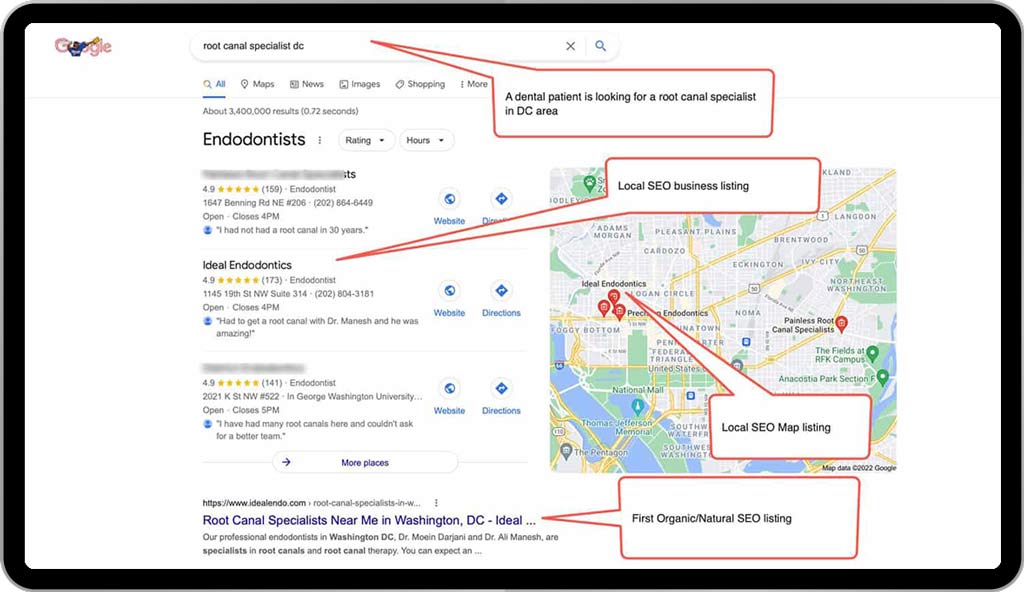
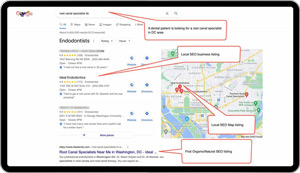
As a dental practice, you need to apply top-notch search engine optimization strategies to your website. These dental SEO (Search Engine Optimization) tactics will help grow your dental site’s organic rankings. The organic results google, bing, or other search engines display are 100% free. In addition, consider this: According to Search Engine Journal, 70% of the links search users click on are organic. Dental SEO is also known as SEO for dentists and dental practices. High quality unique content not only will build your SEO rankings, but also establishes expertise on your subject matter, authority within the industry, and trustworthiness as an entity. There are four basic foundational steps you must take 1) Mobile website that loads very fast, remove anything that slows your website 2) Content of the website must be unique, fresh, focused on adding value to the reader and easy to understand by the search engines 3) Website links (internal and external) 4) Website must be designed for your own brand, with specific references to the provider pages and procedure pages.
Majority of dental providers and dental practice managers believe that when they refer to Dental Search Engine Optimization or Dental SEO, they really mean 1) Higher rankings in Google search engine 2) Appearing in the top area of Google search 3) Appearing in the Google My Business results (local SEO) 4) Google paid ad being displayed in the top area. Dentist SEO is very similar to medical SEO. The key difference is that for dentist’s SEO to be successful, you will need to have many SEO pages written for each dental service provided by your practice. As a dental marketing expert, managing and improving your dental SEO is included in the monthly service from PatientGain.
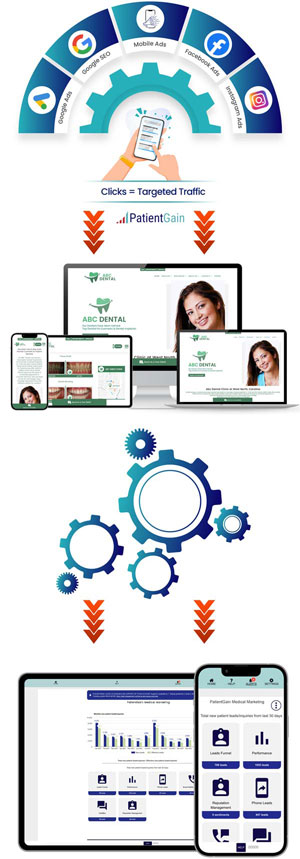
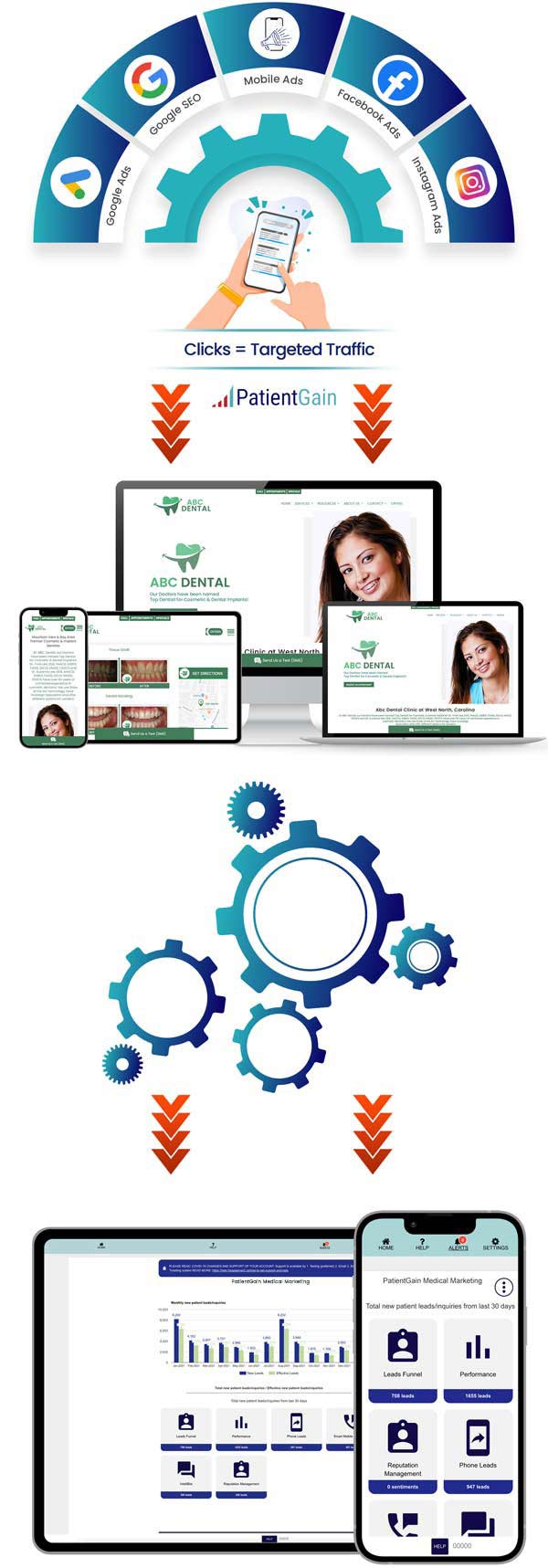
Technically no 4 is not considered Dental SEO, it is dental SEM – Search engine marketing or paid ads. However for our dentists and dental practice managers, we will use this broader definition. See some examples of dental SEO here.
Google maintains a market share of over 90% when it comes to search engines, so SEO improvements are often geared towards Google search engine. The more often you can be at the top of a page for search results, the more likely you are to get potential patients to your website and grow your patient count. While dental SEO results take time to appear, the long-term benefits of this marketing effort cannot be denied and should be a part of your healthcare marketing plan. The experts at PatientGain.com have years of experience helping dentists improve the SEO of their dental websites. We serve 1) General dentists 2) Endodontists – root canal specialist 3) Oral and maxillofacial surgeons, TMJ specialists 4) Orthodontists – alignment specialist 5) Pediatric dentists 6) Periodontists – gum specialists 7) Prosthodontist – replacement specialists. Below are some dental SEO tips and are among the things we do to help your website rank high in organic results. SEO for dental practice does not happen by itself. You will need to focus several areas to get high SEO rankings for your dental practice. It will also take many months before you start seeing results from the SEO. There are additional dental marketing strategies that should be considered. Advertising on Google and social media sites can also be beneficial.
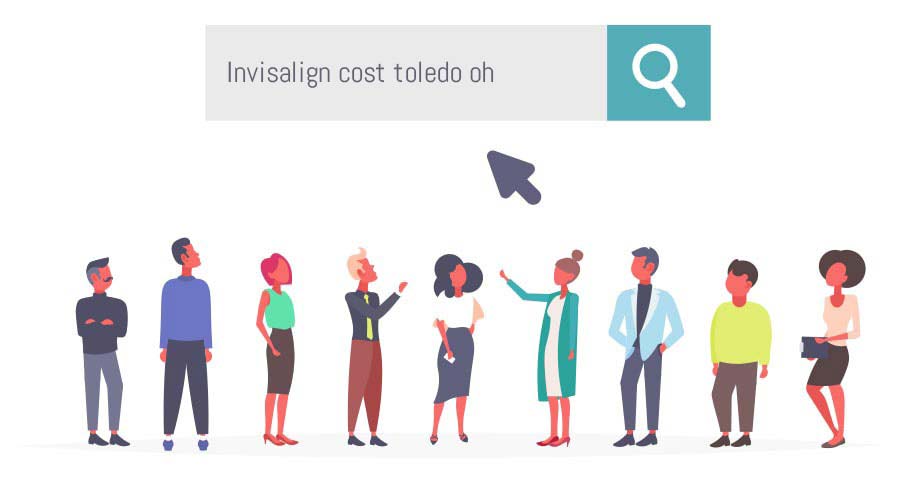

51 key dental SEO questions asked by dentists and dental practice managers:
Table of Contents:
1. Evaluate What Keywords Your Website Has And What Keywords Are Missing
2. Short Tail Keywords and Long Tail Keywords
3. Advantages and Disadvantage of Short Tail Keywords
4. Advantages and Disadvantage of Long Tail Keywords
5. Technical Dental SEO
6. Off-Page Dental SEO
7. How to Acquire New Dental Patients
8. How many new patients does a dental practice need in a month to maintain their business and grow?
9. How can a referral network help dental practices acquire new patients?
10. How can online scheduling help a dental practice acquire new patients?
11. How can a dental engagement chatbot help acquire new dental patients?
12. How can managing a dental practice’s online reviews and reputation help it acquire new patients?
13. Is dental SEO and dental SEM different?
14. Is dental SEO profitable? Does it make sense to invest into dental SEO for my dental practice?
15. Is dental SEO a secret? or can I learn about dental SEO?
16. How is dental marketing ROI (Return On Investment) calculated?
17. Do I need to hire a dental marketing expert?
18. What is dental SEM?
19. I do not see my SEO rankings on page 1 of Google search, but search console shows that I am getting so many SEO clicks for certain keywords – What could be the problem with Google search data?
20. Why is SEO for dentists so difficult?
21. What determines the effectiveness of a dental practice website?
22. How much does a typical website for a dental practice cost?
23. Does traditional advertising for dental practices still work?
24. How can search engine optimization and content marketing help orthodontists acquire more patients?
25. Are there any specific marketing steps that have been proven to be successful for other dental practices?
26. Is the Bing search engine important for dental SEO?
27. What is dental SEO Marketing?
28. What is dental SEO?
29. Why do dentists need SEO?
30. What are the key factors used by Google’s SEO algorithms for dental SEO?
31. If I switch over to PatientGain’s GOLD or PLATINUM service, will I lose my current website’s dental SEO?
32. Why dental SEO depends on detailed procedures knowledge and content writing skills?
33. Do I need a detailed plan for the SEO of my dental website?
34. Generally, what are typical cost areas for a successful dental marketing plan?
35. How can search engine optimization help a pediatric dentist get more patients?
36. How to attract uninsured patients to join your dental membership program
37. Pros and cons of social media marketing in dental marketing
38. Dental SEO VS Dental PPC Advertising – Which one produces better ROI
39. What is dental patient LTV?
40. Can I just buy dental practice SEO ?
41. Once a patient visits my website, how do they contact a dental practice?
42. I am an endodontist (root canal specialist), do patients look for me online or should I be only building referrals?
43. How does a patient marketing database differ from an EMR? Why would a dental practice have a patient marketing database?
44. Does dental advertising work? Are there any tangible examples of digital dental advertising?
45. How can I promote my dental products?
46. What should be included on a dental website?
47. How is conversion rate calculated of a dental website?
48. How long does it take for dental SEO to start working?
49. What is EAT algorithm and does my dental website needs it?
50. What is dental practice branding?
51. Additional related topics to dental SEO:
Answer: Chances are you already have some essential keywords on your website in your content if you have had a website for a few years. With that said, you should always check so you have the right keywords on the correct pages. This area should be a part of your SEO evaluation. Many keywords and phrases are associated with your dental practice. Some of these words should be on every page, while others are specific to individual pages. For example, you will want the words “Dentist,” “Dental,” and the name of the town you operated out of on practically every page. However, keywords related to root canals should be on the root canal service page, and keywords about cavities should be on its service page. Inserting every keyword onto every page regardless of its relevancy, will not improve your organic ranking. This tactic is called “Keyword Packing” and is frowned upon in the world of search engines. If detected, you are likely to be penalized by search engines, hurting your overall organic rankings.
When selecting what keywords to focus on for your Dental SEO, you will want a nice mix of medical terms and terms everyone uses. If you use only medical terms, you will likely miss out on some patients who have no idea what you are talking about. You will also miss patients who will not use those words in the search engine query and use more common keywords. If they are not on your website, it will be hard for you to rank organically. If you use only common keywords and avoid medical terms, your website will not look authoritative to a search engine, and your organic rankings will again suffer. For example, if you have a service page talking about root canals, you will have “Root Canal” on that page as an SEO Keyword. You will also want to check to see if the medical term is on there: “endodontic therapy.”
To select what keywords to focus your dental SEO efforts on, review every page of your website. Make a list of words that should be on every page and then a list of only on some pages. That should be a good starting point for building your keyword list for your dental SEO marketing plan. Put some time into some research and look at related keywords to the ones you have selected. You may come across keywords you have overlooked or discover others, you did not realize were associated with your current selection. It will help round out your dental SEO keywords and increase the chances of success with your efforts.
Dental SEO Example – Patient searching for a family dentist. Patient located in Toledo Ohio
Answer: While you have likely heard of SEO and other terms associated with search engine optimization, you may not have heard or understood these two: Short Tail Keywords and Long Tail Keywords. While they may sound like a breed of wild animal with a winter hunting season, they are different kinds of keywords you use for dental SEO. Knowing the difference between the two will further refine your keyword list to make it more effective. Much like using medical terms and everyday phrases for dental ailments, you will also want a nice mix of these two types of keywords.
– Dentist
– Root canal dentist
– Same day dentist
– Emergency dentist
– Cavity
– Cavity Filling Repair
A long tail keyword, as you may have guessed, is somewhat the opposite. It is more than three words, and it less broad and more targeted. While a short tail keyword will bring in more traffic, long tail keywords bring a higher conversion rate. If someone uses a long tail keyword in their search, they are looking for something specific, and if your website is presented to them, you have a higher chance of converting them into patients. Some examples of long tail keywords for dentists would include:
– Dentists that accept Blue Cross Blue Shield
– Dentists with low self-pay rates
– Emergency Root Canal On Weekends
– Free Dental Exam For Children Under 10
– Walk-In Dentist Open After 5 pm
Answer: Short tail keywords, unlike their Long Tail brethren, have a high web traffic volume associated with them. Generally, the shorter your keyword phrase is, the more volume you will get because it is broader. If you can get your dental website to rank in the top three for a short tail keyword, chances are you are going to get a significant amount of traffic. Keep in mind; however, if you are launching a website, these keywords will be among the hardest to rank for when starting your SEO plans. While your overall goal should be to rank high for as many short tail keywords as possible, they are a few challenges you will face.
Competition for short tail keywords tends to be very high. Everyone wants to rank high for them, so these words tend to be on every dental website. Some short tail keywords may even be incorporated into the name of a competitor. If you want to rank high for “Dentist,” expect stiff competition if your competitors are “The Friendly Dentist” or “Pottstown Dental Solutions.” The shortest and broadest short tail keywords will be challenging to rank for in search engines. For example, unless you are an international dentist conglomerate, ranking #1 for “dentist” could be difficult. Ranking #1 for “Dentist near me” is easier to accomplish, but as you can see, that is a longer keyword phrase. For keywords using “near me” Local SEO often plays a strong role.
While you will get a lot of traffic using short tail keywords, there are two disadvantages you should keep in mind. The conversion rate of those visits to your website is likely to be low. You may get more visitors to your website using short tail keywords than long tail keywords, but the conversion rate will be lower. If getting traffic is your goal, then great, but you do want potential patients to make appointments at the end of the day. Conversions are low because short tail keywords are less focused and do not target people as precisely as long tail keywords. “Dentist” or “Dentist near me” is very broad. That potential patient may be looking for a service you do not offer. You might appear as a top result, but they may move on once they discover you do not provide a service after visiting your website. With that said, there is a percentage of this traffic where you will be precisely what they are looking for. Hence, short tail keywords need to be part of your Dental SEO Plan.
Answer: Long tail keywords are very focused on their target audience, and therefore have a much higher conversion rate. When a potential patient types in a long tail keyword and your website appears, there is a good chance you are precisely the dental practice they are looking for. These keywords generally do not have much in the way of competition, compared to their short tail keyword brothers and sisters. Many dentists will use these keywords to highlight specific services they offer or denote certain dental practice traits. For example, a dental practice may use long tail keywords to showcase late hours, be open on weekends, or treat children. These specific aspects of a dental practice cannot be adequately highlighted using short tail keywords. Therefore long tail keywords must be used to bring attention to these services or unique attributes.
A targeted audience with a high conversion rate is advantageous, but there is a disadvantage to long tail keywords. Unlike short tail keywords, the traffic you see from these keywords will be low. It is a valuable audience that will visit your dental website, but it will be a small audience. Depending on the nature of your dental practice, this may be your goal. However, generally, you do want a fair amount of traffic to improve your organic rankings and grow your patient count. Long tail keywords work hand in hand with short tail keywords to bring you a healthy amount of potential patients to your website to convert them into regular patients.
Answer: What goes on behind the scenes of your website is just as important as the content on it. Technical SEO for dental websites looks at a website’s infrastructure to make sure everything is operating correctly. This aspect of search engine optimization is often overlooked or not fully understood outside of those who specifically work in this area of marketing. If ignored, you are putting your dental website at a disadvantage to your competitors.
One of the biggest killers of organic rankings is site speed. In today’s world of next day shipping and on-demand video downloads, people do not have the patience to wait for something to load. Your website needs to load within a couple of seconds on any desktop, tablet, or mobile device. Site speed is a critical factor in dental SEO, and technical SEO addresses it. The most common reason for slow site speed is unoptimized pictures on a webpage, videos loading, or multiple snippets of code, all trying to load simultaneously. Optimize these areas of your website, and you can expect your site speed to go up. In a very simple strategy, remove or fix everything that slows your mobile website.
Your website must also be mobile-friendly. Majority of your web traffic likely comes from mobile devices. With that in mind, your website needs to have the same functionality on these devices as it would on a desktop computer. Good technical dental SEO will ensure your website loads correctly and is functional on a mobile device. Search engines are now penalizing websites that do not have an excellent mobile version of their site. Competing with other dentists without a mobile version of your website is like boxing with both hands behind your back. Give yourself a fair fight, and do not ignore site speed.
One of the most import part of dental SEO effectiveness is the speed of the website. As of June 2021, Google now ranks speed of the website, specifically mobile website, as an important factor for SEO rankings.
This new algorithm was launched sometime in mid 2021. Google’s page experience algorithm is designed to reward you for fast loading mobile websites. You can check the performance of your website, or any page at https://web.dev/measure/. It covers 4 major areas:
1) performance
2) accessibility
3) best practices
4) SEO
So as a best practice, your strategy should be to be “green” in all of these areas. When you run tests on https://web.dev/measure/ , enter your website URL, and run it 4-6 times. Then take an average. Remember that this is a tool provided by Google, as a simulator that is close to what Google’s actual search algorithms’ see. So our view is that it is a very good way of evaluating a website. Here is the data from PatientGain’s new dental customer:
Here are the rankings according to Google, before moving to PatientGain’s dental marketing Fast WordPress platform: All score should be in green or 90 or more :
Performance : score of 35 out of 100
Accessibility : score of 81 out of 100
Best practices : score of 80 out of 100
SEO : score of 86 out of 100
After moving to PatientGain’s dental marketing Fast WordPress platform: All score should be in green or 90 or more :
Performance : score of 96 out of 100
Accessibility : score of 98 out of 100
Best practices : score of 100 out of 100
SEO : score of 100 out of 100
Answer: Off-Page Dental SEO involves things that do not appear on your website. The majority of off-page SEO involves backlinks. Backlinks are other websites linking to your website. The more websites that link to your website, the more authoritative you appear to search engines. In turn, you begin to rank higher than your competitors. With that in mind, backlinking is not strictly a numbers game. You want more quality links than quantity. If you aim just to be linked on pages full of other links (known as link farms), you often get penalized in organic rankings. You want to be linked to other quality websites. While your competitors are unlikely to link to you, local business organizations, medical associations, and blogs are often great places to get linked from. If you write a column for a newspaper or get featured in a story, you can usually get a link to your site on the online version of their story.
More likely than not, you will get most of your likes from websites ending in .com. However, it would be best if you tried hard to find ways to get listed on websites that end in .org, .edu, or .gov. These websites are generally considered much more authoritative and will boost your organic rankings much higher than .com websites. However, these are often among the hardest to get linked on. Building backlinks is a long-term process, but you should build a nice, healthy list of sites that link to your dental practice over time. However, you should never try to “buy” links and create artificial back links. This is a recipe for a disaster.
Answer: Dental practices need patients to succeed and grow. The current patient count today will not be the same next month or next year. There are plenty of reasons why a patient may stop coming to a dental practice. The most common causes include:
– Changing insurances that are not accepted at that dental practice
– Moving away from the area
– Finding a dentist that has more services that fit their needs
– Finding a more affordable dentist
– A bad patient experience
Some of these things can be controlled by changes made at a dental practice, and other items will happen no matter what the staff does. The best way to avoid a constantly dwindling pool of current patients is to actively go out and acquire new patients for a dental practice. The experts at PatientGain.com can help!
Answer: The number of new patients a dentist needs to find in a month is difficult to pin down. The more patients you bring to a practice, the better. However, setting a concrete goal will undoubtedly help a dental practice and their marketing team concentrate on what they need to do to meet that number. Several factors should be considered when determining a plan for new patients to acquire in a month. They include:
– How many patients have left the practice
– How many patients are active versus inactive
– How many patients are scheduled for future appointments
– What the local competition looks like
– The population density where a dental practice is located
With those factors in mind, many dental practices have a goal of 10 to 25 new patients in a month. Some, however, may want to set a goal of 25 to 50 patients in a month if they have a high turnover rate of attrition with their current patient count. These numbers should be applied to the number of active dentists in a practice, not the overall practice. 10 to 25 new patients for one dentist is great but will not help a dental practice that counts ten dentists on its payroll.
Answer: As impressive as a dental practice may be, it may not be able to serve every patient that comes through its door. A patient may need a specialist for a dental service, find a dentist that takes their insurance, or perhaps a dental practice simply does not have the capacity to take on the patient and serve them as quickly as possible. Those situations at other dental practices present themselves as an opportunity for your dental practice. Establishing a referral relationship with other dental practices and medical practices can be a great source of new patients to a business. Specialty dental practices, like a root canal dentist, will want to establish a referral relationship with general dentistry practices. General dentistry practices will wish to a referral relationship with family doctors, urgent care centers, and other medical practices that see patients but do not have oral healthcare specialists on staff.
When a referral network is created between a dental practice and their new partner, any new patients that come through the network need to be treated with extra care. Their experience, especially their first time there, needs to be great. If a patient has a negative experience at a dental practice, it could have grave consequences. First, they are unlikely to return for future treatment or services. Second, if enough patients report back to the referring doctor about the poor treatment they receive, they will likely stop sending patients. This will dry up a source of referral patients to a practice after much work was put into building it.
To make it easy for another doctor to refer a patient, the referral process must be as easy as possible. Setting up a secure portal on a dental practice’s website is a great way to make sending medical records easy. The staff at another dental practice will have to take care of the secure transfer of records. Making their job easy will ensure the process gets moved along rather as quickly as possible. To maintain HIPAA compliance, any data sent to a dental practice from a referring doctor must be encrypted and stored on a secure server. From there, those records can be transferred into the patient management system for the dental practice to use.
Finally, please do not neglect the referring doctor and send a thank you note for patients referred to your dental practice. An occasional gift basket will show them that you appreciate the referral relationship. Also, if appropriate, send a note back to a referring doctor letting them know the patient’s status and how things worked out for them.
Answer: People today have taken more ownership in their health care decisions, including their oral health. More so today than before, people are going online to research their healthcare choices. With that in mind, they also like to make appointments as soon as possible once they decide. By offering online scheduling, a dental practice is speeding up the process of securing a new patient.
There are several advantages to online scheduling that dental practices can benefit from. First, the ability to schedule online is not limit by the business hours of a dental practice. It is available overnight, on holidays, and any other time a dental practice is not open. It forgoes the hassle of playing phone tag with a patient trying to find a slot that works best for them. Instead, they can simply select their own appointment time. Online scheduling systems also sync up with a practice’s patient management system. This prevents accidental double bookings, which can lead to a very negative patient experience. As soon as an appointment is made, it is shaded off in the system so no one else can make an appointment.
Online appointments work best when automatic reminders, via email or text, are sent out to the new patient to remind them of their appointment. This helps lowers the “no show” rate among all patients, which tends to be higher amongst new first-time patients. Also, any information entered into an online scheduling system needs to be secured and meet HIPAA compliance rules. Even if a dental practice is not asking for any Personal Health Information (PHI), they are responsible for whatever patient enters into the system.
Answer: A dental practice’s website will be one of the first things many new potential patients will visit and explore before making a decision. Despite the best attempts of a content writer or a website designer, there will be new likely patients who have questions. These questions will either be called in or messaged to the practice. Unless there is someone immediately available to answer the phone, they will have to wait for their answer. A dental engagement chatbot can help speed up that process!
While fairly common in the retail industry, the healthcare industry has found a lot of value in this app embedded into a website. A chatbot is simply a program with prewritten questions and answers that helps website visitors find the information they are looking for or accomplish simple tasks. The goal of a medical engagement chatbot is to intercept some of the most common questions and requests before they are sent to the front desk staff. The staff can then focus on patients with more complicated problems, helping them quicker, providing a better overall patient experience. As for what questions and answers need to be prewritten into a chatbot, simply ask the staff to list the questions and tasks patients most often presented to them. While this will not eliminate all common questions via phone or message, it should help cut down on them. For any question that a chatbot can not answer it will take the website visitor’s contact information and question and store it on a secure dashboard. From there, a staff member can handle them in the office and contact the potential patient.
The advantage of a chatbot is that it is always available, much like online scheduling. It will assist website visitors if the phones are busy, overnight, or in the middle of a holiday break! A chatbot is also highly customizable. If a new question starts becoming more frequent, it can easily be reprogramed to address it. For example, many chatbots were reprogrammed, and new COVID-19 questions were added in 2020 when many patients called healthcare facilities with questions. When the pandemic finally subsides, many of these questions will be removed and replaced with other questions.
Answer: Other than a website, many new potential patients will also research the reviews of a dental practice before making their first appointment. These reviews need to be monitored, managed, and cultivated to give a dental practice a good shot at acquiring that potential patient’s business. If a dental practice ignores their reviews, they risk making it easy for a competitor to scoop up new patients that were meant for them.
The first step in reputation and review management is creating or claiming a listing on one of the major review websites: Google, Yelp, and Facebook. While Google will be where the vast majority of your reviews will live, Yelp and Facebook also tend to get a few reviews that must be monitored. To claim or create a listing on Google and Yelp, it needs to be verified by phone or postcard. This process is not challenging, but it must be followed to get access to the reviews. Once claimed, make sure all listings have the same information as a dental practice’s website. Confirm and correct any mistakes involving:
– The name of the dental practice
– Address, including office or suite numbers
– Phone number
– Hours of operation
– Website URL
Managing reviews that patients leave is critical. Replies back show future potential patients that feedback is monitored and respected by a dental practice. For positive reviews, simply thank them for their patronage and tell them that the practice looks forward to serving them in the future. Negative reviews need to be treated more carefully. Do not threaten or bully a negative reviewer into changing or deleting a review. Taking this tone will not make a dental practice look good and could generate negative publicity. If the negative reviewer can be identified, the dental practice owner should contact them to see if their problem can be addressed before writing a response. There is a chance they will change their review to a more positive one, but even if they do not, it can then be mentioned in the response as further proof to others that feedback is taken seriously. Sometimes the negative reviewer can not be identified. They either left before registering, used a different name for leaving reviews, or may have even mistaken a dental practice for another business. In this case, simply say that they can not be found in the patient records and ask them to call to talk about their experience.
Finally, to cultivate reviews, a dental practice simply just has to ask. Negative reviewers are generally more motivated to leave comments. Nudging and asking satisfied patients is more than enough to get a reliable percentage to leave feedback. The most effective review requests either come via email or text message. A dental practice should strive to make the process involve as few clicks as possible. You will lose reviews for each additional click in the review process. One-click should be all that is needed to have them start to leave their kind words. Email review requests tend to be cheaper than text message review requests, but text messages will have a higher conversion rate. Some dental practices use both to maximize the chance for them to receive positive feedback.
Answer: Yes, dental search engine optimization or dental SEO refers to results displayed by the search engine in response to a search query or a search sent by a person using a keyboard or speaking to a device, like Apple’s Siri on an iPhone or Amazon’s Alexa device.
Dental SEM stands for dental search engine marketing. This refers to paid ads on search engines like Google, Bing etc. Usually, but not always, paid ads are displayed in the top area of a search results. This is also known as PPC ads, referring to Pay-Per-Click ads.
Dental SEO and dental SEM compliment each other but do not replace each other. However there is an overlap between both of them.
Answer: Often, PatientGain gets inquires from dental practice managers and dentists, and key question asked is “Is dental SEO profitable? Does it make sense to invest into dental SEO for my dental practice?” The answer is, YES, and let’s walk you through a real customer. Doctor Accardi DDS, has been in his private dental practice for 20+ years. He is located in southwest USA and in a very competitive area. He has been focused on transitioning his general practice dentistry to more focused dental practice on 1) dental braces 2) Invisalign 3) all-on-4 dental implants 4) porcelain veneers. Using PatientGain’s dental marketing solution, without spending on ads on Google and Facebook/IG, the follow results were achieved.
Base line in month 1 – Using PatientGain’s Platinum service $1299/mon. 176 new patient leads received. This is the first month after going live.
In month 4 – Using PatientGain’s Platinum service $1299/mon. 277 new patient leads received.
Results: Dental SEO takes time and is difficult. However, we have seen excellent ROI (return on investment) from dental SEO for dental practices across the USA and Canada.
To learn about how to calculate dental marketing ROI (return on investment), see this page. It covers the formula and examples.
Answer: First, dental SEO is not a secret. Google has a very good blog to learn about SEO. Dental SEO or medical SEO is based on algorithms and data intelligence. Google original search algorithm was invented by two Stanford university students in Palo Alto California, about 20+ years ago. It has been constantly refined and updated. Google has spent billions of dollars on its search technology. PatientGain believes that Google search engine is the most accurate search engine in the world. Many times we also get asked “What are the basics of Google search engine?” This is answered by Google staff very nicely on this page.
Answer: Dental marketing ROI is calculated by (Total revenue generated Minus $ spend on campaign ) Divided by $ spent on a a campaign. So you have to have data in order to calculate the results.
You can read more and see examples on this page.
Answer: For a dental practice to grow and acquire new patients and replace ones they naturally lose through attrition, they need to have an effective dental marketing plan. Many make the mistake of doing this themselves. With all of the other demands of running a successful business, an owner may not give the marketing area of their dental practice the attention it needs. Contracting with a professional dental marketing expert will help be beneficial for your dental practice.
Answer: Dental SEM stands for Dental Search Engine Marketing. Although some may switch these terms, SEM and SEO are not the same things. SEO, or search engine optimization, is an element of SEM, or search engine marketing. SEM uses both paid and organic results to promote a dental practice’s website. The other part of SEM, other than SEO, are pay-per-click ads or PPC ads. These two elements of SEM often work together to enhance the effectiveness of each other. SEO involves improving a website using keywords to appear in the organic results of a search query. PPC ads involve selecting target keywords to bid on so that a website will appear in a paid result. SEO improvements will often make PPC campaigns more effective. For example, bidding on a target keyword for a search engine marketing campaign is much easier if that word frequently appears on a dental website. If a dental practice wants ads to show up for root canals when people search for them, it is easier to win that bid if that keyword appears in the content. Some dental practices may start to ignore PPC campaigns once their SEO work begins to show results. This would be a mistake for them to do this. First, it allows competitors more room to advertise, potentially taking patients away from a dental practice. Also, it can be compelling for a potential patient to see a dental practice appear in both paid and organic results. Effective SEM marketing has both an SEO and PPC component working together to attract users to a website.
Answer: This is a common question asked by dental practices, and by other healthcare practices. First thing to understand is that each person does not see the same results, and mobile results and desktop results are not the same. There are 200+ factors considered by Google’s search engine, before it displays search results. User’s location, past search history, device, behavior, settings, and many other factors. In this case, a dental practice located in Palo Alto California is concerned that their SEO rankings are not working. However, they are looking at the big screen of the computer in the dental office, and most patients are on mobile devices. Mobile results are not exactly the same results you will see on a desktop. Here are some details that may describe the issue.
1. Approximately, 82 Percentage of patients searching for dental services are doing so on mobile devices.
2. When potential patients search and look at the mobile device, the top area is usually Google paid ads.
3. As these patients scroll down, next they will see local SEO results from GMB (Google My Business)
4. Google may also display common questions asked by patients.
5. Next the user will typically see SEO results.
6. However, many users will now “scroll further”
7. At the bottom part of the mobile screen, there is “See more” , which will load more results.
8. If a user clicks on any of the questions, or See more to scroll further, they are no longer on page 1, however they are still likely to click on your SEO rankings.
9. So data from Google’s search console is accurate, and the dental practice, in this case, may not see their ranking in the top area, but they are still getting clicks on the SEO, and hence leads.
10. So the SEO is working and results in the Google search console are correct. (See some screenshots below)
Dental SEO example: Patient looking for “dental implants near me”.
This is page 1 view on a mobile device.
If the user clicks on any questions, they may not be on page 1 results of the Google search results.
At the bottom part of the mobile screen, there is “See more” , which will load more results. If the user clicks on any of the questions, or See more to scroll further, they are no longer on page 1, however they are still likely to click on your SEO rankings. So the results from search console will count these clicks as search results related to the original keyword.
This can explain that you may not see your SEO results on the page 1 of Google search, but you are still getting benefit from SEO clicks. So the data from Google search console is accurate.
Answer: Dental SEO or SEO for dentists and dental practices is complex and is constantly changing. It is based on data science, human behavior, search algorithms, and 200+ factors considered by Google ‘s search engine. Since over 90 percentage of the searches happen on Google search engine in the USA, most SEO professionals focus on understanding how Google’s search engines algorithms work. There are many other search engines, but based on PatientGain’s experience, Google is the most accurate search engine. It delivers value to the the user, a person person who is searching for a specific item or service or any subject. PatientGain also believe’s that Google delivers value to advertisers also.
Answer: Majority of the dental practices believe that by having a nice looking website, with moving images, perhaps a nice background video in the top area of the dental website, will cause the website to be attractive, and cause patients to call your practice. The truth is that your dental website should be pretty, but it must have 3 basic properties : 1) It must load within first 3 seconds. 2) It must have useful content, as perceived by Google search engine and your patients (content has to be unique, cannot be copied) 3) It should promote 3 things a) your services b) Your practice and location c) the main providers.
There are 9 specific areas to consider:
1) Is the website designed for your practice, and for your brand? Is it attractive?
2) Does the website cause the patient (potential or new patient) to take an action, called “conversion”?
3) Does the website provide useful information to a potential or new patient , called “content”? This is crucial for your SEO rankings also
4) Does the website work on all devices like, mobile, iPad, desktop?
5) Does the website load within 4 seconds or less?
6) Is the information collected from the website stored securely in a HIPAA compliant database?
7) Does the website have intelligence?
8) How is the technical structure of the website, is it designed for high SEO rankings?
9) Is the overall design of the completed website gone through A/B testing?
Read more about dental websites effectiveness here.
Answer: Dental websites can be created by the owner of a practice, without any costs. There are many free website companies. However, in the business world, there is never a free lunch. The free websites have a catch. Next level is Sub $1000 inexpensive websites. These websites usually have copied content and are hosted on cheap servers. This can be a good start, if you are not focused on growing your dental practice every month, or perhaps you are in an area where there is no competition for 50+ miles. Some companies offer the same websites for $1000 to $2000, with few minor changes. There are many good companies who offer websites for $3000 to $5000 price range. These companies have experience and have some results to share with you. Next level is $5000 to $10000 websites. In our research, if a website costs more than $3000, it must be A/B tested and should have non-plagiarized, high quality content and it should load within 3 seconds per Google’s guidelines.
Generally, you should consider 4 main costs:
1) Initial dental website set up.
2) Monthly hosting and management fees.
3) Advertising costs – Like Google ads, Facebook, Instagram ads.
4) Fees for HIPAA compliant apps – For example, CRM, Lead capture apps, Chat*Bot, Reputation management, Texting apps, Email marketing apps, Payment apps, Monthly SEO content writing costs.
However, you can avoid costly setups, and highly inefficient marketing strategies by simply using PatientGain’s GOLD or PLATINUM monthly service. Consider GOLD monthly service for $799/mon from PatientGain or PLATINUM monthly service for $1299/mon from PatientGain. Both of these services include A/B tested website, great customer service, SEO, and 20+ apps to help your dental practice grow.
Answer: In advertising, there are two types of marketing they can consider: Digital Advertising and Traditional Advertising for your dental practice. While some marketing experts will tell you that a dentist will not have any use for traditional advertising in today’s digital world, that is not exactly true. While it is accurate to assume digital advertising will take the lead in most marketing plans, traditional advertising plays a role if appropriately used. The experts at PatientGain.com can help a dental practice navigate both digital and traditional advertising methods to support a dental practice so it can grow and succeed.
Answer: To the majority of the public, dental care involves a dentist. Beyond that concept, there is not much knowledge about the different types of professionals in this field of medicine. As such, effective marketing and advertising are needed. An orthodontist works in oral healthcare, but many people may assume they are just another regular dentist. However, while all orthodontists are dentists, not all dentists are orthodontists. Marketing and educating a target audience about this difference will help an orthodontist grow their business.
Orthodontists are specialists. Orthodontists are specialists who focus on bite and alignment of teeth. According to American Association of Orthodontists, Orthodontists have 3,700 hours of orthodontic training. So as we market you, our focus is to differentiate you from a general dentist. Read more about marketing for orthodontists.
Answer: Much like marketing for other areas of the health industry, modern dental marketing generally relies on digital and online marketing strategies. Successful dental marketing plans will invest in various areas of online marketing to reach current and new patients. Digital marketing is constantly changing, but some areas have remained constant over the years. A well-rounded dental marketing plan will include both digital and traditional marketing tactics to succeed. Read more about specific tactics that work for a dental practice.
Answer: Yes, Bing is the 2nd most used search engine in USA. Bing search engine (Microsoft) should not be ignored. If you use PatientGain’s GOLD or PLATINUM service, we also focus on Bing SEO rankings for your practice. Bing search engine is the 2nd most used search engine in USA. It is also the default search engines for millions of new PCs sold. According to Gartner in 2020, there were more than 275 million PCs sold. So Bing search engine is also important for your dental practice’s SEO.
Answer: Dental SEO marketing is one of the most potent tools available to a medical marketing specialist looking to boost the organic rankings of a dental practice’s website. When new patients begin their dental health journey, they will start their search using a search engine. The search engine has long since replaced the telephone book for people who are looking for local services. The idea behind dental SEO Marketing is to make sure a dental practice’s website shows in the top results when people search for the services they provide.
A search engine will return millions of results on millions of pages. The vast majority of people searching online will not look past the first page of results. Many do not look past the top 3 or 5 results on a page. As such, a dental practice needs to appear in those top results to grow its business. Dental SEO marketing assists with that by giving search engines a better understanding of a website and how it is relevant to various keywords a typical target audience will use when searching online.
Dental SEO marketing is, by in large, considered to be very cost-effective if done correctly. The time and effort put into good SEO work now will give benefits for quite a while. If a dental practice can lock in a top spot in search results, it is often challenging to dislodge them from that top stop without a considerable amount of effort. With that said, it does take time to see results. Unlike Pay Per Click campaigns, where someone writes an ad, sets a budget, determines the targeting, and begins to see the ad the next day, SEO is not as immediate. It can take up to 4 to 6 months to see the fruits of SEO Work begin to impact a dental practice’s organic results. A dental practice needs to be patient. Changing or tweaking dental SEO marketing plans every day or every week will not give it the room it needs to develop and gain traction. Constant changes do not help a search engine better understand the context of a site. This time can take longer if competitors catch wind of a practice’s SEO improvements and begin improving their website. While not every competitor will monitor your site, you should monitor your most formidable competitors. They are trying to improve their SEO rankings just like you.
Dental SEO marketing is also something that is constantly evolving and must be monitored. Excellent SEO work that solidified a dental practice’s #1 result spot in search engines may not be able to hold up over time. As new services become available and other search phrases begin to be used more, a dental practice may find its rankings fall over time because they did not update their site’s SEO. Monitoring SEO and looking for developing opportunities to get good rankings on emerging keywords and phrases should be one of the goals of an effective dental SEO marketing plan.
Answer: The concept of applying dental SEO to a dental practice’s website is relatively easy to understand: making it easier for search engines to rank a website in search results. The process of applying dental SEO to a website can be rather complicated and time-consuming. Again, it is cost-effective, but there needs to be a commitment to do it right to pay off in the long run. One of the first things that need to be done is to draw up a list of keywords a target audience is most likely to use when searching for dental services. These keywords need to be peppered throughout the content of the entire website where they are relevant. For example, if a practice offers root canals, the keywords related to root canals should be on that service page, and some should be on the home page. They should not be on pages that describe other services, like braces or getting cavities filled. Keywords also should not be overused. Plastering content with too many keywords is frowned upon by most search engines and it will penalizes organic rankings.
When determining keywords for dental SEO, a practice needs both short-tail keywords and long-tail keywords. Short-tail keywords tend to cover broad topics, drive more traffic to a site, and are three words or less. Short-tail keywords, however, have lower conversion rates. Long-tail keywords, in turn, have higher conversion rates, are four words or more, and cover particular topics. However, they tend not to drive as much traffic to a site. Long-tail keywords are also becoming important when people use voice search on smart speakers or digital personal assistants. People tend to ask questions that are four words or more, and if a dental site can match that question and provide the answer, it will rank higher and higher.
Another thing that impacts organic rankings covered by dental SEO is site speed. How fast a site loads will significantly impact the user experience and the overall organic ranking of a site. A slow site speed can derail even the best dental website. Patients today want things quickly, and if a site does not load in a few seconds, they will return to the search results to look for another solution. Search engines track the behavior of users, and if too many immediately come back and look at other results, then that dental website will seem less relevant. Search engines also want to provide a good user experience for that consumers. Search engines regularly test a website’s site speeds, and those results impact rankings. The most common culprits to slow site speed generally are unoptimized pictures, movies playing directly from the site, and code interfering with other code on the site. Site speed is a technical aspect of a website, and the reasons that are slowing down a site is often not very apparent. An experienced SEO specialist is needed to weed out the issues and fix them.
Not all dental SEO work takes place on the actual site. Off-page SEO is another aspect of dental SEO that dental practices need to pay attention to grow. Unfortunately, off-page SEO is often beyond the direct control of a website designer, but just because it can not be controlled does not mean it should not be considered. Off-page SEO usually involves other sites that link to a dental practice. Getting these referral links can be challenging to do, and it takes time and patience. Avoid getting links from sites known as “link farms,” which are websites that only have links and provide little if any content of value. The most common places a dental practice can get linked from are when they join medical associations or business organizations. These groups often have directories of members that will list various contact information, including website URLs. Another way, although a little more complicated, is when news outlets publish stories online about a dental practice or column is written by one of the providers. Online versions of these stories are often linked to a dental practice and can provide incredible SEO value. Sites ending in .com are going to be the most likely source of referral links. Occasionally, although immensely challenging, a referral link might come from a more valuable .edu, .gov, or .org site. Links from these sites often make the site look very important in the eyes of a search engine.
Answer: Dentists need SEO so they can reach as many people in their target audience as possible. While a dental website may perform okay without dedicated SEO work, they are sure to miss an larger audience they could use. For a dental practice to be successful and grow, they need a steady influx of new patients. The current patient count they have today will not be the same patients they have a year from now. Patients drop off for a variety of different reasons. Some common causes include:
– Moving away
– Changing insurances
– A bad experience at a dental practice
– No longer needing their services
– No longer being able to afford the care there
– Switching to a dentist that is close or has better availability
Without a constant flow of new patients coming in through the front door of their facility, a dental practice will struggle to succeed.
A dental practice needs dental SEO because many of its competitors actively use this marketing technique for their business. If ignored, these competitors will not only take patients that a dental practice is leaving behind, but they will start creeping in and take away the patients they currently have. Strong Dental SEO work is needed to maintain good rankings and fend off any upstarts opening a new practice in the area.
The effective use of keywords also will, as an additional benefit, make pay-per-click advertising more potent as well. PPC ads use target keywords when promoting a dental practice’s site in paid results. The more targeted keywords appear in content, the more relevant the ad will look to a search engine marketing platform. For example, if a dental practice is advertising search results promoting braces, but there are hardly any keywords related to this service, costs will go up. If the keyword being targeted is not even showing up on a dental practice’s website, the ad might be blocked altogether from being shown. As another example, if a dental practice were bidding on the word “hot dog” to show a dental practice ad, it would be difficult and expensive, if not impossible, for that ad to show in search results. However, if there were a page with content about dental practices and mentioned hot dogs throughout that page, there would be a better chance of it appearing and costing less.
Dental SEO is just one crucial part of a dental medical marketing plan. On its own, it can help significantly improve the quality and conversion rate of a dental website. Working with other medical marketing strategies, such as content marketing, can be an amazingly effective marketing tool.
Search engine optimization is a concept that many owners of dental practices should be aware of and have heard before. Despite the widespread awareness of the idea, not all owners and doctors at a dental practice know what it does or if it is an essential part of their dental practice’s medical marketing plan. Some may feel that it only needs some occasional, casual attention and, in the end, does not matter much one way or another. However, SEO is a vital part of a dental marketing plan for a dental practice and should be considered a pillar of a successful marketing plan.
SEO helps a dental practice rank higher in organic results. Unlike paid results, organic results are free, so it is beneficial for a dental practice to appear there as often as possible. When someone makes a search query on Google, it will return billions of results on millions of pages. Despite this large selection someone can select from, nearly 100% of all search engine users will only look at the first page of results. It is critical for a dental practice to appear on that first page of results and, if possible, appear in the top three returned results. They will get the most out of organic results if they appear on the first page.
An important thing to remember when it comes to successful SEO work is that it takes time to see results. Unlike paid ads, it may be months before a dental practice will see tangible results in their SEO Work. This slow but steady change needs to be given the patience to succeed. Organic rankings do not change overnight unless there is massive volatility in organic rankings. Once SEO improvements have been made, they must wait up to 6 months before seeing any real organic ranking improvements. With that in mind, a practice is only hurting itself if it tweaks its SEO words every week, hoping to see results quickly. SEO needs time to gain traction and find its feet so to speak. Frequent changes can confuse a search engine and result in the subpar organic growth of organic results. With that said, SEO keywords need to be monitored. If a previous keyword has fallen out of favor and is getting fewer searches, try to determine if a new keyword has become popular. SEO for the site needs to be updated regularly to maximize its effectiveness.
For dental practices to truly get the most benefits from good SEO work, they need to spread keywords throughout the content. Trying to stuff as many keywords as possible into a content page will result in organic penalties from search engines. Instead, keywords should be spread out across content on-page and be relevant to that page. For example, a content page talking about braces should not have keywords related to root canals or any other dental service. A dental practice needs to stay on topic with its keyword usage. If they do, they will find SEO to be much more effective.
Finally, for search engine optimization to be effective and pull more potential patients to a site, a practice should use both short-tail and long-tail keywords in their SEO work. Short-tail keywords are three words or less and cover very broad topics. They tend to be very popular with competitors and therefore are very competitive to rank well for in search results. They can send high amounts of traffic to a site but tend to have low conversion rates. Long-tail keywords are four words are more and focus on narrower or unique topics. Since they are a bit more specific, they tend to be less competitive and not used as often by competitors. While they drive smaller amounts of traffic to a site, they also have higher conversion rates. Long-tail keywords are also playing an increasingly important role in voice searches. Voice searches are most common with smart speakers and personal digital assistants. Here, people will ask questions, usually four words and longer. If these questions can be matched on a site, there is a better chance for a dental practice to be the top result.
Answer: Google does not provide exact steps and details of the SEO algorithms – It is a closely guarded trade secret. However Google has provided many good blogs, articles and her staff has provided many pointers over the years. Here is a summary list : 1) High-quality content (cannot be copied from another website & must be written just for your dental website). 2) Structure and coding of the website – Does it load in less than 3 seconds. If you are using website code that was not written for speed and optimization, your SEO will suffer 3) Page speed. 4) Page experience per Google’s tool https://web.dev/measure/. 5) On-page SEO optimizations 6) Internal-linking. 7) External linking. There are additional 200+ SEO ranking factors. In short, if your focus is to provide value to the website reader (in this case a potential dental patient or an existing dental patient), and make it easier for the Google’s search engine to understand your content, you will have good SEO results.
Answer: No, you will not lose your SEO rankings. Any knowledgeable SEO company will take basic steps to ensure that your SEO rankings will not be lost. Here are some simple steps you can take. 1) Using Google’s “site:” option, find out which pages are already in Google search. 2) Make a list of all URLs 3) Study the H1s, Meta tags, and content of each page. 4) Create a mapping file of all current URLs 5) Optimize each URL to new URLs – Sometime you will need to shorten long URLs. 6) Add 301 redirects in the new website – so all old URLs are captured 7) Make sure that you update nameservers and other domain settings to new web-server. 8) You may have to account for https forwarding URLs.
Once the new site is live, adding Google analytics, search, tags should be completed. Once the new website goes live, there may be 2-7 days of time frame, where you may see some rankings as “missing” from results. This is normal, as the Google search engine’s algorithm’s are adjusting to the new website’s structure and content.
If you have followed the above steps, and some other best practices, you should not see a decrease in SEO rankings. 100% of our customers see an improvement in the SEO rankings. However it is not a simple “one step” or a switch. It is a process that will take time. From a few months to many months. Here is a very good video from Google’s staff.
Answer: For a dental practice to get constant, quality web traffic, they need to rank well in organic results for their top keywords. While they can undoubtedly get some traffic from pay-per-click (PPC) ads, this can be costly and likely can not be maintained. Good organic rankings depend significantly on a site’s search engine optimization or SEO. Good SEO is impacted by a dental practice’s detailed knowledge of procedures and their ability to write good content their site. These two factors play a significant role in a dental practice’s SEO and its effectiveness at promoting its website. Learn more how a dental SEO content plan can help your dental SEO rankings.
Answer: Your dental website will need high quality, non plagiarized content, focused on providing value to the visitor. Mainly you have these target audience: 1) New potential patients. 2) Existing, returning patients 3) Search engines. 4) Other providers (who will potentially refer patients to you) 5) Local PR, news agencies. 6) Your social media pages. 7) Engagement apps
So as a savvy business person, dental practice manager you want to attract all of these target audiences. Read more about SEO content plan here.
Answer: There are many areas, like human capital cost, opportunity cost and cost associated with managing any project. However, there are 6 key areas typically needed:
1. Setup of a dental website – usually one time charge – This could be an “update” of a current website, or a new website
2. Monthly marketing activities – For example, posting on social media, Email marketing, updating website
3. Monthly cost of apps – For example, Texting/SMS app, Chat-Bot app. Appointment app, Lead-capture apps, Offers app
4. Monthly SEO updates – Improving the SEO of your website every month, this is required if you want to stay competitive
5. Support of a professional to assist you (you will need marketing + technical resources)
Lastly No 6 – Probably the most expensive area – You will need to advertise – If you want to compete with other companies, who are similar to you. Cost of advertising is extra and varies from location to location and type of healthcare practice. Monthly advertising activities could include, for example, advertising on Google, Facebook, Instagram and other digital properties. Read more about how much other practices spend on advertising.
Answer: Although pediatric dentists serve children, their parents will be the ones that ultimately make the selection of the provider that will suit their family. The vast majority of those parents will begin the journey to make a dental care choice with a search engine, usually with Google, as it still maintains a significant market share in the search engine market. While search engines return millions of results when people conduct searches, most, if not all, users will only look at the first page of results. Pediatric dental practices must appear on the first page of results for those seeking their services. Using search engine optimization, or SEO, is widely accepted as one of the best ways to do that.
Answer: There are likely many people in a community that probably do not have dental insurance. There is potential to grow a dental practice and make additional revenue from this target audience that may think they have no oral healthcare option. The uninsured dental market can be very lucrative, causing some dental practices to avoid signing contracts with health insurance companies altogether. The key process of making revenue from uninsured patients is having an effective medical marketing plan. Many dental practices have tapped into their community’s uninsured dental patients to implement a dental membership program. Many programs are organized and run in-office, cutting out fees that a third party usually take. Dental practices across the country that started on have found them to be very successful. Learn more about dental membership plans.
Answer: Social media is playing an ever-increasing role in the lives of people. It also is becoming a tool in healthcare that doctors and other providers are more comfortable using. However, as with many new advances in technology, there are pros and cons to using social media in healthcare. While many believe social media, as a whole, is a net positive to healthcare, below are some pros and cons to social media in healthcare to consider.
Pros of Social Media in dental marketing
a) Ability to spread information faster to the public
Social media is widely regarded as a way to spread information incredibly fast. In the past, it may have taken valuable time to get the word out about an important health topic. Today, it can take moments to spread information throughout a community organically. When something “goes viral,” it is actively being shared and sent to people by their friends and family.
b) Debate of educational information is possible
Just as it is easy to spread information, it is easy for people to connect and discuss topics. Thought leaders and healthcare experts can post their thoughts on topics and engage with others. Many often post their comments to their colleagues, share their work, or engage with others to answer their questions. This can lead to a better understanding of healthcare topics and get more people involved with it and educated
c) Making it easier to connect and develop relationships with others
Many dentists and healthcare facilities use social media to stay engaged and connect with their patients. Previously, communication and contact would only come when patients were at facilities for appointments. Social media allows them to check in with their providers more often and build trust in the doctor-patient relationship. Social media also allows connections between patients and doctors that they previously did not have access to due to distance. Anyone in the world can bring their expertise to assist with healthcare issues with patients. Social media helps them connect and share their knowledge with a large audience.
d) Empowers women and minorities in healthcare
Social media is a great way to showcase the achievements and professional highlights of women and minorities. Social media can share pictures and posts of these updates with a broader community. Many social media channels incorporating live streaming into their platforms opening up a broader world to connect with others. There is less of a need to depend on publications and organizations to highlight the accomplishments of these providers and doctors.
e) Helps Healthcare Businesses Fill Positions
Social media is a powerful tool for recruiting new staff and providers. Some social media networks, such as LinkedIn, are specifically designed for this type of networking. Many healthcare businesses post job listings on social media instead of taking out expensive ads in traditional media, like in a newspaper. From there, their followers share these job listings on their pages and send them to qualified friends and family members. Some social media channels, like Facebook, let you put special sections on profiles highlighting various available openings.
f) Improves quality of life and helps reduce some health problems
Feeling connected with others plays a significant role in the mental health of others. Before social media, some people had trouble connecting with others or even staying in touch with people who lived far away. Many people felt alone in such a big world, which could be overwhelming at times. Social media allows people to stay in touch with others they have met in their lives and seeks out people with similar interests. They can join online communities where distance is not a factor, only one’s internet connection. Social media has helped people remain active and connect with others.
g) Discussions are facilitated between healthcare providers
The world is a smaller place because of social media. Regardless of distance, various professionals can exchange ideas and consult. Instead of just listening to someone on the phone, providers can now Livestream with each other, share data in real-time, and talk about various health issues. These can be limited to a single patient, where one doctor is calling in to provide expertise for a medical issue. In other cases, a public discussion about a pressing health topic can be organized. For example, regional doctors and directors of medical systems organized online public chats about COVID-19 safety and answer public questions when the pandemic started in 2020. These types of connections to other doctors and the community are valuable.
h) Help grow patient counts
In addition to communicating with others, social media can be a powerful marketing tool. A healthcare facility can promote its services, share positive reviews, and encourage people to use its facilities. While this promotional message should be mixed heavily with non-promotional messages, it can convert visitors into patients. Another aspect of social media is social media advertising. Many, if not most social media platforms have robust marketing tools available. These tools allow healthcare businesses to target users for paid promotional messages. Like search engines, these promotions can target people by location, such as by zip code or town. In addition, it can also target people by gender, age, and interests. While this reduces the number of potential people to advertise to, this refined audience is often more likely to convert into clicks and appointments.
i) Especially Helps Senior Citizens Stay Connected To Society
As the population ages, more and more senior citizens are comfortable using social media. Some senior citizens, whose first brush with new and exciting technology as an adult was the cassette tape and VHS, have quickly adopted this new form of other communication. Others need some assistance from their children, grandchildren, or even great-grandchildren. Social media allows senior citizens to connect with family and old friends. They can also easily keep up to date on news, trends, and what younger generations are talking about. They may even find themselves participating in conversations with others, offering their advice, or asking others to explain different changes in culture to them. While they certainly use the internet to watch old shows online that they enjoy, they are no longer isolated from the rest of the world and can easily participate no matter where they are in the world.
j) Quickly spread new information or story related to public health and safety.
Whenever an area suffers from public health risks, social media is usually the first to post an alert. For example, if there is a suspected measles outbreak, social media is usually where the first location a statement is posted. While news organizations will likely cover it with a story, it may be hours or days before that story reaches people. Social media allows a critical health alert shared by a community and other news organizations as more details are learned. A great example of this is during the early days of the COVID-19 outbreak. Restrictions on public gatherings were usually announced over social media first or as news conferences were being held. Those who were not watching the news but were following news via social media would see those alerts and share them with their communities. News, advice, updates, and health information of high importance can be spread quickly.
k) Expose the public to new advances in research
Great use of social media is showcasing new advancements and breakthroughs in healthcare. While these were already featured in peer-reviewed journals, they did not reach beyond the academic or research community. While some do get regional or national coverage from news agencies, there are still countless other advancements that go unnoticed by the public.
Social media has allowed researchers, schools of health, academic journals, and organizations to spread the news of these discoveries. Entire articles and research results can be posted online and shared. Some researchers even utilize social media to engage in Q & A for the public or other colleagues. Some research studies set up social media accounts so the public can follow their research online and be kept up to date as quickly as they making discoveries. Social media has opened a large world to many people both inside and outside healthcare.
a) The spread of false medical or health information
Just as accurate, usable, and actionable information can easily be spread across social media, so can misinformation. While social media channels have started to police this better, it is still very easy to share the wrong information. When false information gets pulled off social media, it has usually been shared by so many people that it is already out there and has gone viral. In addition, when false information gets pulled off of social media, those who most fervently believe it see it as proof that someone is trying to hide “the truth.” It can also lead to additional stress for people who “Doom Scroll” through mountains of misinformation.
b) Social media can sidetrack those who manage their time poorly.
While social media is a great communication tool for healthcare businesses, it can impact the efficiency of a practice. Plenty of studies indicates that employee productivity suffers when access to social media is available. A quick check of social media can quickly turn into 15 minutes of looking at cat videos or looking at the production notes of a movie someone has not seen in 20 years.
With that in mind, a healthcare practice needs to ensure that the employee or staff member in charge of any onsite social media is good with their time management. Posting a picture of the facility on a snowy day is fun to connect to patients. However, 45 minutes finding the “perfect shot” is not a good use of time. Certain other guidelines should be in place for other employees to help them keep on task. With that said, an employer should be mindful not to be overbearing. Employees tend to resent an employer that monitors their activities to ensure they spend no time on social media. Find a happy medium.
c) The negative impact on relationships
Social media can help keep people connected, but it can still cause stress and tension in those relationships. People may resent seeing pictures, posts, or activities online that they were interested in but were not invited to or shared with. It also is not uncommon for people to misread messages or posts on social media. Context, tone, and sarcasm are just some things that can be difficult to convey in text. A playful joke might be seen as an insult to someone else. Playful banter may be perceived as flirting by someone’s partner. These things, while minor, can build over time and cause relationships to become strained or broken.
d) Social media is designed to help people communicate and help people waste their time on platforms.
The goal of social media is to facilitate communication between people and keep as many people as possible using it as frequently as possible. The same things that get potential patients to notice a healthcare facility’s post or paid ad are the same things that will distract employees at work who use social media and at home. Time spent on social media is less time spent with family or outside physical activity. Many health problems are associated with a sedentary lifestyle, and hours on social media do not help that. More time spent on social media also means less time reading, creating, or learning new skills.
e) Employees can embarrass their employers with social media posts.
A problem that is becoming more and more of an issue with healthcare businesses are their employees’ social media activities and, even in some cases, their managers, owners, and CEOs. Unless an account is set to private, anything posted on social media is available for the world to see. Any member of a healthcare entity (staff, doctor, manager, owner, CEO) represents that company while at work and outside of work. There have been many stories of employees, doctors, owners, and CEOs being fired or resigning due to their social media activity. Their commentary on a controversial topic, much like a post about pressing health news, can be shared, commented on, and “go viral.” Controversy often has a great chance of going viral than regular news because people will debate others about it. Healthcare companies need to clarify to anyone associated with it that their social media activities may impact their employment if they embarrass the company. Freedom of Speech and the 1st Amendment does not apply to private companies. Freedom of Speech does not mean Freedom from Consequences.
f) People get so used to engagement, lack of engagement can cause mental disorders.
It is always nice to receive a like or comment on posts or pictures on social media profiles. However, some people’s lives begin to revolve around getting as many likes or comments as possible. Some have even built careers are around being “Social Media Influencers.” Some start to suffer from mental health issues if they do not think they get the engagement they deserve. This can lead to depression and sometimes cause people to take unnecessary risks to produce content. There are many stories about social media influencers who lost their lives performing stunts or getting content for their followers. They would have never put themselves in that position if social media wasn’t such a central part of their lives.
Answer: When a dentistry is marketing their practice, their website will be a significant part of that dental marketing plan. A dental practice will want to promote that website to attract more patients. While there are many ways to promote a website, Dental SEO and Dental PPC Advertising are often considered the two main ways to promote a website, in addition social media marketing can also be useful. A dentist needs to stand out from their competitors and establish a brand. If they can build patient loyalty, they can grow and keep an edge over their competitors. While in the past, word of mouth and referrals from friends and family were enough to keep a dentist in business, they must use Dental SEO and Dental PPC Advertising to promote a well-designed website so that they appear as often as possible to a potential patient.
A dental practice will rely on search engine optimization for long-term exposure and success. So SEO takes time (months) to be produce effective ROI.
Given enough time, good SEO work will help boost the organic rankings of a dental website. If target keywords can achieve and maintain good rankings, it will increase traffic to the website from people within a target audience looking for a dental practice. The organic rankings of search engines are free. A competitor can not buy their way to the top, although they can spend that money to improve SEO and content to be more relevant in search results.
PPC (Pay-per-click) advertising provides a dental practice with immediate visibility in search results.
The most prominent advantage dental PPC advertising has over dental SEO is its immediate results. Once a PPC campaign is set up, assuming the correct relevant keywords are selected, and enough budget is allowed, a dental practice should see its ad begin to run within 24 hours. PPC advertising is helpful for dental practices when they want to promote specific services to specific places. For example, if a dental practice wanted to promote teeth whitening in one zip code but emphasized pediatric dental services in another zip code, that could quickly be done with PPC advertising. The immediate results and performance tracking make PPC advertising very effective and provide good ROI to a dental practice.
If Dental SEO and Dental PPC Advertising start simultaneously, Dental PPC Advertising provides better ROI in the short term. However, as time goes on, Dental SEO’s ROI will slowly but surely rise and soon be on par or provide a better ROI than PPC advertising. Dental PPC Advertising provides better ROI when focusing on specific services promoted by a dental practice. Dental SEO has better ROI when promoting the overall brand of a dental practice, and long term returns are much higher for dental SEO. As you can see, there are several variables to look at when determining which one provides a better ROI. Read more about Dental Advertising VS Dental SEO.
Answer: LTV stands for Life Time Value of each patient.
For example 1 if Susan (a patient) stayed with you for 6 years as a patient, and she spent $600 per year on routine dental services, her LTV is $3600
For example 2 if Bob (a patient) stayed with you for 6 years as a patient, and he spent $1600 per year on routine dental services, his LTV is $9600
If you take an average of your dental patients, you should find that each patient’s LTV is approx $5000 – For a general dentist. This is different for each type of dental practice. For example if you a dentist who focuses on dental implants, and specifically All-on-4 implants, each patient is $20K to $30K . Learn more about dental patient LTV.
Answer: No. You cannot just buy the SEO of dental practice from Google or from any search engine. SEO (Search Engine Optimization) or natural results from search engines have to be built over time. To start building the quality SEO for your dental practice, first put yourself in the shoes of a potential and existing patient. Your new potential dental patients will find you from these sources:
1) Google SEO (Learn more about how healthcare SEO works)
2) Google local SEO (Learn more about how local SEO works)
3) Google Ads (Learn more about how Google ads work)
4) Facebook, Instagram Ads (Learn more about social media advertising)
5) Digital ads on other secondary websites(Insurance websites, healthgrades, vitals, and other medial and dental directories etc)
6) Offline traditional advertising (Newspapers, Yellow pages, billboards, leaflets, flyers, USPS mailed attention grabbers)
7) Referrals (Referrals from your network of other providers)
8) Word of mouth (Existing happy patients tell their family members, friends and neighbors)
9) Ecommerce apps (Like Amazon, etc)
However majority of your patients will find you from the first 4 sources. So your strategy should be to provide useful information on your website. There are specific steps you will need to take for the conversion strategy of your website.
Answer: Majority of the dental patients will see your website on a mobile device ( approximately 82%), so your dental website must load within 3 seconds and it must be simple but must be A/B tested for conversion strategies. Your website should make it very easy for your patients to contact you and ask questions. If you have a multi-channel engagement apps, you will receive more patient inquiries, hence more patients. Patient inquiries should be kept in a HIPAA compliant database, and then automatically added to a “Leads Funnel”, which is a patient marketing database. Patient marketing database is NOT your EMR; EMR are designed to hold data about patient’s records, and after they become a patient. Prior to becoming a patient, every patient is a “prospect patient”.
Dental Patients contact you using:
1) Phone (This is still the no 1 way patients contact you, so call tracking is indispensable)
2) Texting/SMS (Instant Messaging from your website, in the form of a text/SMS – No 2 way patients contact you)
3) ChatBot (Automated ChatBot should be HIPAA compliant and mobile optimized)
4) Appointment request (There are 4 different ways an appointment app can be configured to increase conversions)
5) Redeem or Click on Buy-Now promotion (Extremely important for self-pay options)
6) Contact form (This is a common way for a patient to send you a request from your website, but it must be HIPAA compliant)
7) Sign up for your monthly newsletter (Very effective to capture Emails)
Answer: Short answer is YES, you should build your online strategy. Every day there are millions of searches on Google for specialists. Patients are directly look for endodontists. See example below. Patient is looking for a root canal specialist in Washington DC area.
Answer: EMR(Electronic Medical Record) systems were never designed for marketing or sales. They have always been designed to hold data about patient medical or dental conditions, procedure codes, treatment plans, allergies, and other healthcare related information. The data is typically added as a patient creates an account into the patient portal. Hence the data about the patient is “AFTER” a potential patient becomes a patient. So question is, where do you store the information about a “potential patient”. Let’s assume John Doe contacts you to ask about “Do you offer dental implants for seniors” ? This a potential patient lead and this can be worth few thousand dollars to over $30,000 for All-On-4 dental implants. So if you have a patient marketing database, you will have a superior marketing system, and will have a clear advantage over other dental practices. Read more about patient marketing database.
Answer: Yes, digital advertising works. There are dozens of ways you can advertise your dental practice, and you can do so with very good ROI (Return On Investment). However, it takes to see results. There is no “quick fix”. You need to work with a specialist dental advertising and marketing company, to reduce your risk, and a company that uses digital data to constantly improve your returns. See 6 key examples of dental advertising examples here.
Answer: Not all dental practices are only about oral healthcare services. Some dental practices will have products to sell. Much like routine check-ups and filling cavities, these products need to be successfully promoted. A website can be a great tool to promote dental products from a practice successfully. Dental products need their section of a medical marketing plan so they can get just as much attention as other parts of a dentist’s practice.
One crucial way to promote dental products is through content marketing. A search engine loves content to the point where “Content is King” is a guiding principle for most medical marketing plans. The content related to dental products is an area that is sorely under-appreciated by most dental practices. As such, a practice can get the upper hand over their competitors if they put time into developing content for their products, which is in this case are the product descriptions used on sites. These descriptions need to be unique, helpful, informative, and include keywords that potential consumers use when searching for them. Unlike content pages for services, not every product needs a 1000 word product description unless a practice decides to have a separate page for each product. (That might be excessive depending on the number of products sold).
Many dental practices make a mistake because when they sell a product from a vendor by cutting and pasting the product description onto their website provided by the vendor. This is a fairly common mistake in many industries selling things online. Only recently have major retailers seen the value of putting time into creating unique product descriptions. For content marketing to be effective, it needs to be unique. If a dental practice is using the same words to describe a product that dozens of other dental practices are using to describe it, then it will not be unique or authoritative. The description provided by a vendor is undoubtedly an excellent place to start, but a dental practice should seriously consider rewriting it to be unique and make it their own. Consider expanding on it a little to talk about the symptoms or treatments related to the product and link it to a treatment page where the product would likely be recommended. This will go a long way to promoting a product and help the overall SEO of a page.
The next step in promoting dental products on a website is to buy them online. If the only way to purchase products from a dental practice is to come in and purchase them from the front desk physically, the owners should not expect much in sales. In today’s world of online shopping, there is not much of a point to list a product online if it can not also be bought online. A robust eCommerce system needs to be implemented to facilitate online sales for a dental practice. Practically all of the population has had some experience with online shopping, and therefore some things are expected.
First, the connection between the person and the website needs to be secure. There needs to be an SSL connection on a website to produce the financial information, like the credit card number, of the person making the online purchase. An SSL connection is standard now across the internet. The most popular modern browsers will put up a big warning message letting users know that the connection is not secure and that any private data sent may be at risk. If someone sees this screen, they are likely to move on to a different site for purchase. An SSL connection is critical.
Another critical part of selling products online is keeping track of inventory. A good e-commerce system will know how many items are available and automatically make something unavailable once that number is reached. If a dental practice needs to take things up and down when supply is low manually, they will run into a situation where a sale is made but will have to be canceled because they are out of stock. This is a poor customer experience and will not lead to repeat sales. The other part of the selling items online is shipping. A dental practice will compete heavily with other sites, like Amazon, that offers quick shipping that is often free. If possible and practical, provide free shipping or a very low flat fee. Finally, try to get it out the door as fast as possible once an order comes in. Post the estimated shipping time on a site for items, update it as needed, and stress if there are any usual delays. For example, if a dental practice is closed Saturday and Sunday, orders placed Friday night will not be addressed until Monday. Also, if practical, include tracking on products so consumers can track the progress of it and not call the practice for updates.
Answer: What should be included on a dental practice’s website is a fairly open-ended question but an important one to ask. Most dental websites do an excellent job at telling site visitors the type of services they can expect if they choose it for their dental care. However, many dental sites are missing other components that could help improve their overall SEO.
A. Staff & Dentist Bios
Many dental websites miss the opportunity to feature their providers and staff by providing their bios on their websites. Some owners may shy away from this, fearful that competitors will swoop in and steal their employees. While this is not an entirely unreasonable concern, not including bios on a website will not immunize them from competitors offering employees new jobs. With social media channels like LinkedIn, it is not hard to contact an employee who may be open to a career change.
The advantage of posting staff bios is that it is great unique content for search engines to eat up, boosting SEO rankings. It is also an excellent way to put a “face” on a dental practice and have patients connect with the people who are treating them. Content from a new or updated staff bio also makes for great social media posts, email marketing newsletters, or in some cases, direct mail marketing campaigns. Keeping this page up to date is key to good staff and dentist bio pages. If an employee with a bio leaves, remove their profile from the page and add one for a new hire. Finally, be sure to update their profiles if they get a new certification, graduate from a school, and any links if they appear in news articles.
B. Directions Page
Dental practices can boost their local SEO by including a directions page on their website. All sites should have the dental practice’s physical address on every page, but they should also have a page specifically dedicated to the directions to the dental practice. A practice should write out how the route someone would take to arrive from multiple directions and communities on this page. These directions should include specific street names, landmarks, and even the names of businesses they will see along the way. This information will help a search engine understand where a dental practice is located and better present it as a map result in search results.
A directions page should also, if applicable, include public transportation information as well. Those who do not have immediate access to cars will find this information tremendously helpful. Include the names of any subway, train, bus, or regional rail stops close to a practice. If the business is located in a major city, there may be multiple buses, subway, and rail lines to mention that depends on the person’s travel direction. Finally, embed a Google Map onto the page to let people find directions without leaving the website. This map will help both local SEO and organic SEO on Google, and it is very easy to implement.
C. Services Pages
Once of the most overlooked pages is the main dental services page. And on this landing page, there should be clear strategy to place high margin based services in the top area. Each service should have it’s own page. For example if you offer “Same day cerec crowns“, at your practice, you should a separate page
Answer: First, let’s explain what is conversion rate.
Conversion rate is:
1f 100 potential new dental patients visit your website, and 18 patients take an “conversion action” from your website, then your conversion rate is 18%. Conversion rates can range from 2% to 30% . For example if a dental patient searched for “Invisalign dentist near me” and your website’s SEO results are in the top area of Google search page, and if your website has a full page about Invisalign braces, and your website loads within 3 seconds, you are likely to get that specific patient take an action. The action could be calling you. This would be considered a “conversion”. Read more about website conversion strategies on this page.
Answer: According to Google SEO staff, dental SEO marketing companies and agencies should set proper expectations for dental customers. It takes 4 months to 1 year to start seeing benefits of SEO and improvements in rankings. However let’s dig deeper into this statement. The following is based on general examples, and cannot applied to “any” dental website, so you should consider them as guidelines, rather than firm data, as every website, location, practice is different and your competition changes constantly.
Use case: Existing dental website with history.
This means that you have a current functional dental website with at least 1 year history. And you have decided to use PatientGain’s GOLD or PLATINUM monthly service.
1) Low competition – will start seeing results in first 1 to 2 months.
2) Medium competition – will start seeing results in first 2 to 3 months.
3) High competition – will start seeing results in first 3 to 6 months.
Start seeing results means that you should start seeing improvements in rankings. It does not mean that you will be on the top the Google search results immediately. See examples of dental SEO here. Learn more about key factors for SEO improvement.
Use Case : New dental website, new URL – with no previous history. Basically you are starting from zero SEO.
1) Low competition – will start seeing results in first 2 to 3 months.
2) Medium competition – will start seeing results in first 3 to 7 months.
3) High competition – will start seeing results in first 6 or more months.
Answer: For a dental website, E-A-T stands for dental Expertise, dental procedures Authoritativeness, and dental provider Trustworthiness. Google’s search algorithms use over 200 different signals to measure the effectiveness of a website, and hence the value to the reader. In this case, the reader is a potential or an existing patient. So the algorithms “Read” your website and measure these three items (in addition to many other factors)
Expertise: For example, if you offer dental implants, does the dental website communicate to the reader that the dental practice is an expert at dental implants?
Authoritativeness: For example, if you offer treatment for TMJ disorders, does the dental website communicate to the reader that the dental practice and the providers at the practice have years of experience.
Trustworthiness: This is a broad area, and Google’s search algorithms look at many areas, one of the important areas is your website secure, is your website HIPAA compliant, do you have encryption, reviews about your services.
Read more about E-A-T algorithms here.
Answer: One of the most significant concepts in branding is that when you build a successful brand, customers (in this case, patients) will come looking for you. If you just build a website, you are looking for patients. So at PatientGain we always start by focusing on your brand. What is branding? it is your logo, colors, website, quality of information, bios of each provider, intelligence of your website, look and feel of your business cards, your Linkedin profile, your reviews, and many other ways how you present your dental practice to the world. Branding is all the ways you establish an image of your dental practice in the eyes of your existing patients, future patients, your own staff, suppliers and even your landlord!! Branding gives your patients a reason to choose you over another dentist, and a reason to continue to choose you over going to a different dental office.
Digital Marketing For Dentists & Dental Practices
Dental Marketing Pricing ($199/mon to $1299/mon)
Dental Website Design Cost
What Is Dental SEO, and Does It Work?
How Voice Search Impacts Your Dental SEO
Dental Marketing ROI Calculator Used By Top Dental Practices
Dental Practice Advertising
SEO for Dentists: How to Reach More Patients Online
Dental SEO Keywords
What Is Dental Marketing? How Dental Marketing Works?
What Makes a Dental Marketing Company Helpful to Your Dental Practice?
Are there any additional dental SEO questions and answers?
PatientGain is a dental marketing company that serves all 7 types of dental practices
Dentistry Practices – General dentist
Dentistry – Endodontist – Root Canal Specialist
Dentistry – Oral and Maxillofacial Surgeon
Dentistry – Orthodontist – Alignment Specialist
Dentistry – Pediatric Dentist
Dentistry – Periodontist – Gum Specialist
Dentistry – Prosthodontist – Replacement Specialist
The experts at PatientGain.com are ready to help you with your Dental SEO needs. We can also help you take advantage of new areas of Dental SEO, such as Speech Based Dental SEO. Make an appointment today with our team, and let us show what we can do for you and your business!
